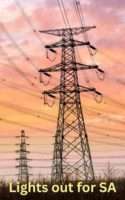How Did We Get Here?
South Africa’s lights first went out in 2007, and more than a decade later, there’s no guarantee that they’ll ever be back on for good. When load-shedding was first introduced, it was under the motivation that power needed to be suspended because of a lack of electricity generation capacity at the country’s biggest coal-fired plants. Despite warnings in 1998 that the electricity supply would diminish quickly, Eskom failed to increase its supply, and the country is facing the consequences today.
Why Can’t We Increase Generation Capacity?
From a lack of trained staff members to failing infrastructure and even corruption, there is no end to the obstacles to electricity creation. But failing infrastructure and corruption are the most problematic of these instances. For example, in March 2023, Daily Maverick reported that four criminal cartels were operating within Eskom, committing fraud within the value chain for their political ambitions. Unstable leadership mixed with politicking and crime only adds salt to the wound of ageing infrastructure and a lack of plant maintenance. Despite the Government’s commitment to improving their Energy Availability Factor (EAF) to 60% in March 2023, with the help of the Energy Action Plan and Electricity Minister Dr Kgosientsho Ramokgopa, our average EAF is only 52% in 2023. And Eskom Chairperson Mpho Makwena says that load-shedding will remain a permanent response for at least 2 or 3 more years.
What Is the Real Impact of Loadshedding?
According to the South African Reserve Bank, stage 6 load shedding costs South Africa about R900 million daily. That’s millions of Rands worth of salaries and wages, as some of the people most hard hit by load shedding are small business owners who cannot afford to keep their businesses functioning during power outages, which occur almost every day in 2023. Consequently, the Reserve Bank has even predicted that economic growth will have reduced from 1.1% in 2022 to 0.3% due to power disruptions.
The impact of load shedding is not only economical, however. Loadshedding impacts food security, health and safety, and crime rates. Farmers have had to lay off workers while their produce rots and their livestock starves, which only means that our access to food is lowered, causing soaring food prices and the cost of living. Similarly, hospitals and clinics need electricity to power their operations, keep their medication under regulated temperatures or light up their consultation rooms. This seriously impacts the country’s ability to offer healthcare to the suffering.
Similarly, crime rates have increased, with petty theft and robberies happening during loadshedding hours. And even though loadshedding was reduced to stage 2 in March 2023, this is not without the trade-off of overriding sulphur dioxide emissions limits and standards just to increase generation capacity in coal-fired plants. This, too, has severe consequences for the quality of air in South Africa and impacts climate change.
What Can We Do About it?
Reading all of this, you may feel like loadshedding is a nightmare that doesn’t have a solution. But good work is being done to pressure the Government to make a change. Civil responses to loadshedding have only mounted in 2023. Legal action has been taken against Eskom by multiple community groups and stakeholders with sway in politics. For example, in 2023, the Lekwa Local Municipality and the Ngathwe Municipality successfully sued and won their Constitutional Court Appeal against Eskom for abusing human rights to dignity, healthcare, education and a safe environment. This was one of the key civil responses that triggered more legal advocacy movements against loadshedding.
Harrington Johnson Wands Attorneys and Conveyancers argue that, according to section 154(1) of the Constitution, Eskom is bound to their mandate to “support and strengthen the capacity of municipalities to manage their affairs, to exercise their powers and to perform their functions”, meaning that loadshedding can in some ways be considered a breach in their role to supply municipalities with electricity. Although it’s unwise to try and make a case against Eskom as a simple individual, together with a group of other affected people, you might just be able to earn some attention. And separate from legal action, you as a citizen also have a right to protest the lack of service delivery you’re receiving.
The DA and its supporters marched to Luthuli House in January, and other civic protests have also occurred in Tshwane, Cape Town and other parts of Pretoria. When the Electricity tariff increase was proposed, civil society groups walked through Megawatt Park, Eskom’s head office, with pickets and signs to show their disagreement. And most importantly, the more sustainable development lobbyists and green movement activists lobby for the move to renewable energy, the more potential we have to end the instability and destruction caused by coal-powered energy plants. Overall, even if major change doesn’t occur immediately, this helps to put pressure on the government to make a serious change.
Power For The People
Yes, loadshedding is a severe issue that devastates South Africa’s citizens, economy and service delivery. But that doesn’t mean we must sit back and watch it happen. By staying informed, sharing information and – where necessary and possible – protesting your dissent of power outages, we can make improvements. The more we argue for movements towards green energy and the end to coal-powered plants, the more we can also hope for sustainable electricity generation in the future.
Tell us: What do YOU have to say about loadshedding?



